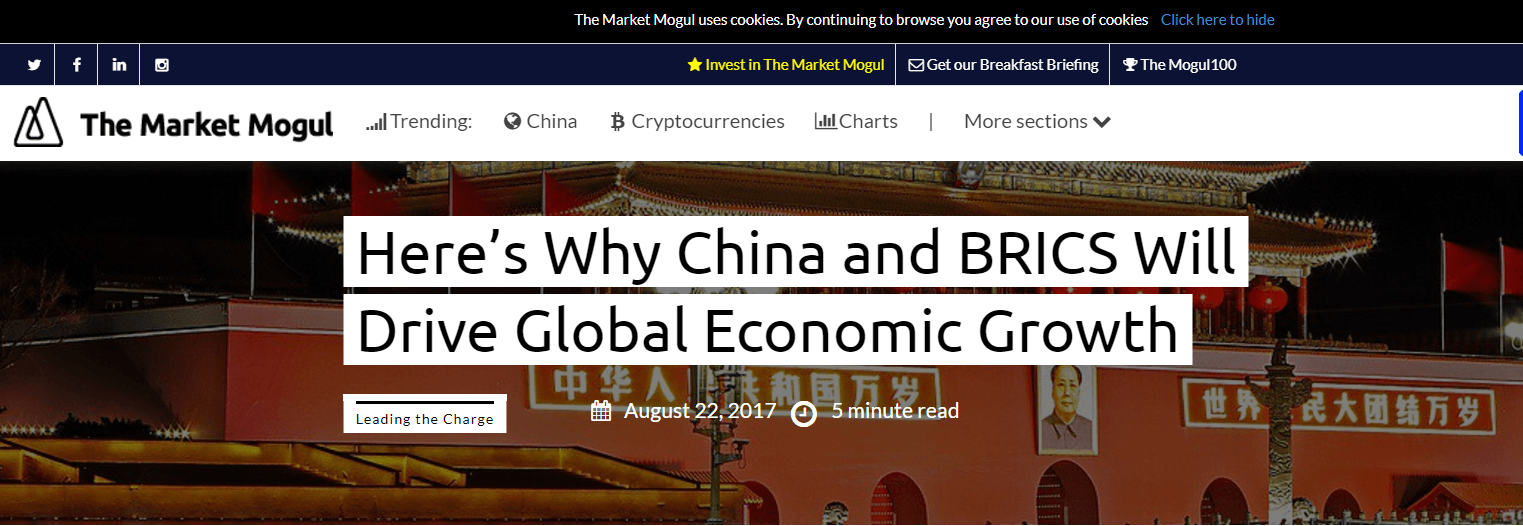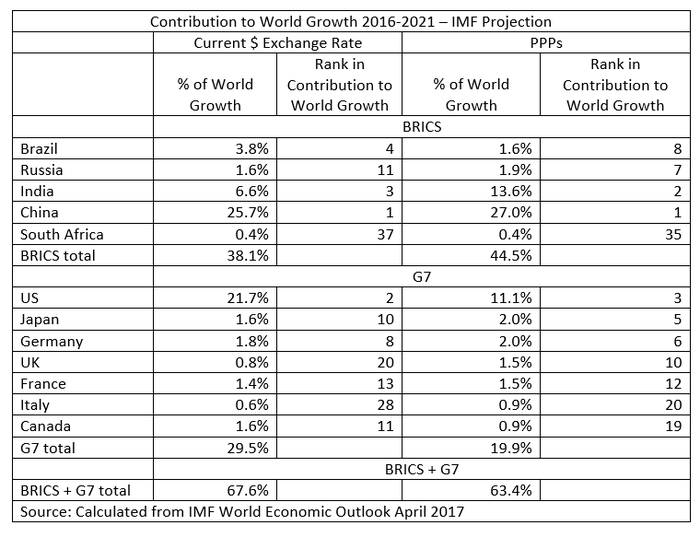It is frequently underestimated just how dependent world economic growth is on only a few countries. Strikingly, on the IMF’s latest projections, the majority of world economic growth in the next five years will come from only three countries – China, the US and India. Collectively these will account for 54% of world growth at current exchange rates and 52% measured in purchasing power parities (PPPs).
This reflects the reality of the extreme concentration of the world economy in only a few states.
This reflects the reality of the extreme concentration of the world economy in only a few states.
- In 2016, at current exchange rates, a mere five economies accounted for 54% of world GDP and 20 economies for over 80% of world GDP.
- Measured in PPPs the concentration of the world economy is only fractionally less – the top five economies accounted for 48% of world GDP and 20 economies for 76%.
Therefore, even extremely rapid growth in a country outside the small group of largest economies, while it will produce desirable increases in living standards for that country’s inhabitants, it will not substantially affect global growth.
Given the domination of global development by a small number of large economies the members of two economic groupings which meet at summit level, the G7 and BRICS, will dominate world growth in the next five years.
- BRICS (the original Brazil, Russia, India, China grouping has now has invited South Africa to join) – which is the most important grouping of developing economies.
- The G7 is the most important grouping of advanced economies.
China remains the biggest growth locomotive
Even within this framework, China will continue to be the single most decisive factor in world growth – while contrary to some assertions that the BRICS concept is no longer relevant BRICS will be a larger factor in world growth than the G7. To show this reality Table 1 sets out the percentages of world growth over the next five years that can be calculated from the IMF’s projections.
No matter how measured China will continue to be the largest source of world growth. Measured in PPPs its lead over the US will be huge – China accounting for 27% of world growth compared to the US 11%.
The data also shows that the role of the BRICS economies is more important for world growth than the G7.
- Measured at current exchange rates, IMF projections show BRICS economies will account for 38% of world growth during 2016-2011 – compared to 30% for the G7.
- In PPPs, the BRICS economies will account for 45% of world growth compared to the G7’s 20%.
Therefore, no matter how measured, the BRICS economies are a more powerful locomotive of world growth than the G7.
Table 1
Misunderstandings on BRICS
Given the dominance of world growth by BRICS, above all China and India, why has the false idea arisen in some media that BRICS was no longer relevant? It was due to a misunderstanding – an assumption the BRICS economies were important because they were rapidly growing, whereas their true importance was that they were extremely large.
Various commentators, wrongly believing that the global impact of Jim O’Neill’s term BRICS was merely an example of skill in coining a good name, made attempts to popularize other groups of economies. For example, Fidelity Investment promoted MINT (Mexico, Indonesia, Nigeria, and Turkey). But no other proposed grouping achieved major recognition, for reasons which become clear when the real significance of the BRICS is understood.
Whether other developing economies grow rapidly or not, and whether or not they represent good opportunities to secure financial returns, the reality is they are too small to decisively affect the course of the global economy. For example, in the next five years, even measured in PPPs, the MINT economies on IMF projections will account for only 6.4% of world growth compared to 44.5% for BRICS. Only one economy outside either the G7 or BRICS, Indonesia, will account for more than two percent of world growth.
Size not Speed
That it is size of the BRICS economies which is decisive is even clearer if it is noted that, with the exception of China and India, neither BRICS nor the G7 includes the world’s most rapidly growing economies – see Table 2. Of the 192 countries for which the IMF makes growth projections then, leaving aside China and India, the other G7 and BRICS countries rank between 143rd and 182nd of the world’s most rapidly growing economies. But nevertheless, due to their size, the decisive role of the BRICS & G7 combined within the global economy may be seen by their combined accounting for nearly two-thirds of world growth measured in PPPs.
Conclusion
In summary, it’s vital not to confuse money making opportunities in small countries with their role in the world economy: size matters. In the next five years global economic growth will continue to be solidly dominated by the G7 and BRICS – above all China.
Table 2
* * *
The article originally appeared at The Market Mogul.
Related articles
Wrong analyses of China – listed by author and date
Numerous authors make wrong analyses predicting an economic crash or drastic slowdown in China and then, when these ...
Read More The first international issue of Wenhua Zongheng is a landmark event for the global left
By John Ross Wenhua Zongheng is a newly launched international publication bringing together articles originally produced in the ...
Read More The CPC has led the greatest improvement in the conditions of the greatest proportion of humanity in human history
Any examination of the facts arrives at a clear conclusion which may be simply stated. The CPC has ...
Read More What is really behind Trump’s obsession with Russia
Two huge US geopolitical relations, with Russia and China, have dominated the early period of Trump's presidency. The strong clashes ...
Read More My new book explaining China’s economic miracle
The new book “China’s Great Road” collects together in English a number of my main analyses of China’s ...
Read More 








